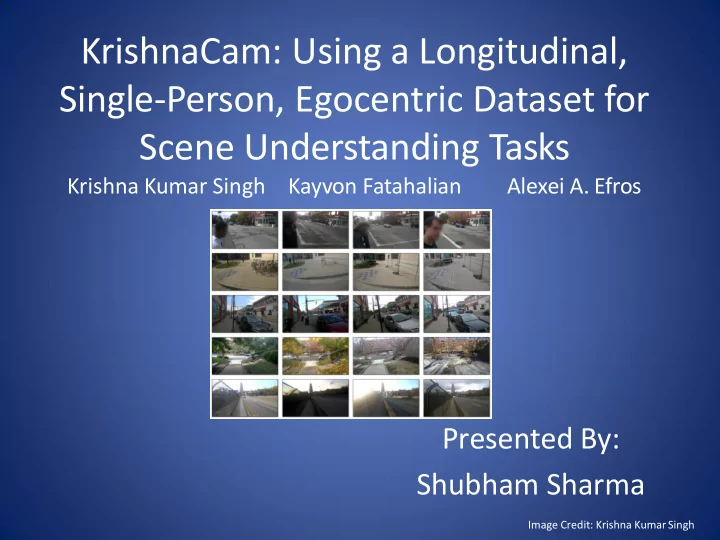

KrishnaCam: Using a Longitudinal, Single-Person, Egocentric Dataset for Scene Understanding Tasks Krishna Kumar Singh Kayvon Fatahalian Alexei A. Efros Presented By: Shubham Sharma Image Credit: Krishna KumarSingh
Objective Organize a large egocentric video collection of real-world data from a single individual into a richly annotated database How much novel visual information does an individual see each day? Can we predict where the individual might walk next?
Motivation • “A baby has brains, but it doesn’t know much. Experience is the only thing that brings knowledge, and the longer you are on earth the more experience you are sure to get.” — L. Frank Baum, The Wonderful Wizard of Oz • The goal is to extract value from life events. Image credits: Krishna Kumar Singh et al.
Agenda Creation of the KrishnaCam new dataset Quantification of novel visual data Trajectory estimation and motion class prediction Experimental evaluation Applications Strengths and Weaknesses
The KrishnaCam dataset • Over a period of 9 months, collect and record the events in the life of a graduate student • Data still being recorded. Heat map of locations visited Image Credit: Krishna Kumar Singh et al.
The KrishnaCam dataset Image Credit: Krishna Kumar Singh et al.
How much novel visual data is present? NN frames constrained to be Lot’s of separated by at redundant data! least 10 minutes Identify top-5 Novel if the nearest neighbors average similarity of frame in prior of its top-5 recordings. nearest neighbors is below threshold or if no neighbor.
Results of Novel Visual Data Growth Image Credit: Krishna Kumar Singh et al.
Results of Novel Visual Data Growth Image Credit: Krishna Kumar Singh et al.
Motion Prediction • Given a single image, can we predict where the student would walk next in the scene? Image Credit:http://paragonroad.com/krishna-pendyala-legacy-by-design-not-by-default/
Motion Prediction: Ground-Truth data How do we get ground-truth trajectories in this huge dataset? Manual annotation? I am not labeling that! Image Credit: https://beinspiredchannel.com/frustrated-frustration/
Motion Prediction: Ground-Truth • Estimating ground-truth motion trajectories: GPS is inaccurate for location prediction. Image Credit: Krishna Kumar Singh et al.
Motion Prediction: Ground Truth • A multi-class SVM is trained with accelerometer and orientation sensor readings. • 4 classes of velocity: stationary, slow, regular and fast. • Using this velocity and orientation, find 7 second trajectories.
Ground truth 7-second motion trajectories obtained from accelerometer and orientation measurements. The red dots represent stationary behavior. Image credits: Krishna Kumar Singh etal.
Motion Class prediction • Ground partitioning. C(f i ) is the final position • To learn C(f i ), modify the final softmax layer of the MIT Places-Hybrid Network to predict nine motion classes • Training: 38 hours (681,565 frames, September 18 to March 2) • Testing: 252,209 frames (collected between 38 and 52 hours) Image Credit: Krishna Kumar Singh et al.
Results • The dataset is heavily biased towards instances of walking straight. • To remove bias, for each training frame, scale the gradient used for back-propagation by the size of the frame’s motion category Image Credit: Krishna Kumar Singh et al.
Results: weighted model Per-class motion prediction accuracy Image Credits: Krishna Kumar Singh et al.
Image credits: Krishna Kumar Singh et al.
Predicting Trajectories • Future trajectory as average of the frame trajectories of top-10 nearest neighbors separated by 10 minutes. • Training: First 38 hours of recording (681,565 frames after temporal subsampling) • Testing: 40,000 test frames (20,000 unvisited, 20,000 visited) randomly chosen from 38 and 52 hours.
RESULTS
Image credits: Krishna Kumar Singh et al.
Image credits: Krishna Kumar Singh et al.
RESULTS Error measure: Distance (in meters) between the predicted position and the measured position seven seconds into the future. Image Credit: Krishna Kumar Singh et al.
RESULTS Results on the SUN database Image Credit: Krishna Kumar Singh et al.
Value of longer recordings Image Credit: Krishna Kumar Singh et al.
APPLICATIONS OF THE DATASET VIRTUAL WEBCAM Image Credit: Krishna Kumar Singh et al.
APPLICATIONS OF THE DATASET • Finding popular places: Correlate pedestrian detection with GPS location. Image Credit: Krishna Kumar Singh et al.
• Single person only! • Creation of a huge egocentric dataset • Failure in trajectory prediction • Using simple methods like NN in fast movement. • New analyses that shed light on • Low prediction accuracy in the nature of an individual’s daily per- class motion visual environment prediction. • No manual annotations required • No novel algorithms created OPEN ISSUE: IS SUCH A DATASET USEFUL FOR MANY APPLICATIONS, AS IT IS EXTREMELY BIASED TO THE LIFE OF A PARTICULAR INDIVIDUAL?
POSSIBLE EXTENSIONS/FUTURE WORK Motion prediction based on recent video history. Using advanced techniques to enhance accuracy. Application of dataset: giving good trajectory predictions to intoxicated individuals. Analyzing motion of other individuals.
SUMMARY Collected a large-scale, motion annotated, egocentric video stream Solve scene understanding tasks Opinion: Great dataset, huge scope for improvement in algorithms
Recommend
More recommend